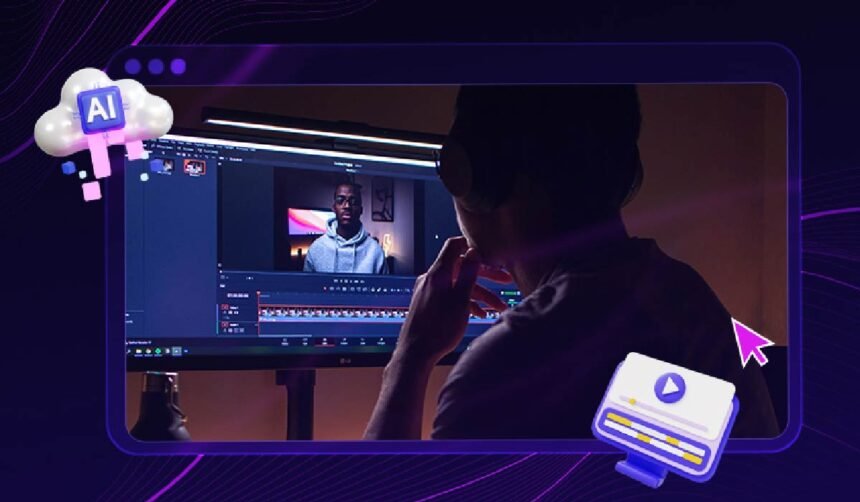The world of video editing has always required a delicate balance between creative vision and technical execution. From trimming clips and adjusting audio to color correction and rendering, the traditional video editing process has often been time-consuming and labor-intensive. But now, artificial intelligence (AI) is revolutionizing how videos are created, transforming raw footage into polished, high-quality content faster and more efficiently than ever before.
Automating the First Cut: AI-Powered Organization
One of the most significant challenges in video production is sifting through hours of raw footage to identify usable clips. AI dramatically reduces the time spent on this step by automatically scanning video content, detecting faces, recognizing speech, and identifying scenes.
AI can categorize clips based on keywords, expressions, or visual patterns, allowing editors to find relevant moments with just a few prompts. For example, if a user wants all the scenes where someone is smiling or saying a particular phrase, AI can instantly surface those segments. This ability to tag and sort clips not only saves time but also ensures that nothing important is overlooked in the editing process.
Intelligent Trimming and Scene Detection
Beyond organizing content, AI tools now assist in generating rough cuts of videos by detecting logical scene transitions. Using machine learning algorithms trained on thousands of professionally edited videos, AI can mimic human editing instincts. It can automatically trim silence, remove long pauses, cut redundant shots, and determine optimal scene changes based on visual or audio cues.
These automatic edits serve as a strong starting point, allowing editors to refine rather than build from scratch. This approach drastically speeds up the workflow, especially for fast-paced industries like news media, marketing, and social media content creation, where quick turnaround times are critical.
Enhancing Visual Quality with AI
Color correction and grading are essential to creating a visually appealing video, but they require both technical knowledge and a sharp eye. AI is now making this process more accessible by automatically adjusting exposure, contrast, saturation, and white balance. With the help of neural networks trained on professionally color-graded footage, AI can replicate cinematic looks with impressive accuracy.
In some tools, users can even upload a reference image or clip, and the AI will match the target video’s color profile to create visual consistency. Additionally, AI-based denoising and upscaling features can improve the quality of low-resolution or poorly lit footage, making it more presentable for professional use.
Audio Editing with Precision and Speed
Sound is just as important as visuals in any video, and AI plays a vital role in enhancing audio quality. Modern AI systems can isolate voices from background noise, automatically balance sound levels, and remove echo or hums from recordings.
Moreover, speech-to-text technologies allow for automated transcription, which not only helps in subtitling but also enables content indexing and searchability. Editors can now search a video by spoken words, jump directly to that section, and make precise audio or visual edits based on the transcript.
AI also assists in generating voice-overs, adjusting music to fit scene lengths, and even recommending background tracks based on the emotional tone of the footage.
Smart Subtitling and Localization
Creating accurate subtitles manually is a tedious task, particularly for long-form content or multilingual distribution. AI streamlines this step by auto-generating subtitles with high accuracy through natural language processing (NLP). It even adjusts for regional dialects, colloquial phrases, and complex sentence structures.
Beyond simple transcription, AI-powered translation tools allow editors to localize content for global audiences. Automatic translation and subtitle generation enable creators to reach a broader audience without requiring native speakers for every language. This is especially beneficial for content creators who publish globally on platforms like YouTube, Instagram, and TikTok.
Creative Suggestions and Style Matching
AI is not limited to technical tasks—it also contributes creatively. Based on the type of footage, genre, or platform, AI tools can recommend editing styles, transitions, fonts, effects, and templates. This is incredibly useful for editors who want to adhere to a specific branding guideline or replicate the style of a viral video.
Some platforms even allow users to input a reference video, and the AI will attempt to mimic its editing style. This “style matching” ability simplifies the creative decision-making process, helping creators maintain consistency across projects or quickly adapt to new trends.
Faster Rendering and Output Optimization
Rendering is the final and sometimes most frustrating step in the editing process. Traditional rendering can be time-intensive, especially for high-resolution or complex projects. AI optimizes rendering by analyzing the video timeline and predicting which sections need more or less processing power. This adaptive rendering significantly shortens export times.
Additionally, AI can optimize final video outputs based on the platform they’re intended for—automatically adjusting resolution, aspect ratio, bitrate, and file size to ensure the best possible viewing experience on social media, mobile, or web.
Human-AI Collaboration in Editing
Despite AI’s growing role, human creativity remains central to storytelling. Rather than replacing editors, AI acts as a powerful assistant that handles repetitive, technical, or time-consuming tasks. Editors are free to focus on narrative, pacing, emotional tone, and overall vision—areas where human judgment still reigns supreme.
The true benefit of AI lies in this collaborative dynamic. By handling the heavy lifting of organization, enhancement, and automation, AI empowers editors to be more productive and innovative. As one seasoned editor put it, “AI doesn’t replace my creative eye—it sharpens my focus on what really matters.”
Real-World Applications
From indie filmmakers and YouTubers to global marketing teams and newsrooms, professionals across industries are leveraging AI to streamline their workflows. The rise of the AI video editor has lowered the barrier to entry for high-quality content creation. Smaller teams and solo creators can now produce videos that rival big-budget productions in both quality and turnaround time.
For social media influencers, quick edits with subtitles, smooth transitions, and engaging graphics can now be accomplished in minutes rather than hours. In the corporate world, training videos, internal communications, and promotional materials are being produced faster without compromising quality.
Future Trends and Implications
As AI continues to evolve, the future of video editing looks even more efficient and immersive. We can expect further integration with real-time collaboration tools, predictive editing suggestions based on viewer engagement data, and even AI-generated storyboards that assist with pre-production planning.
There’s also growing interest in generative AI for video, where entire scenes can be created or enhanced using prompts or text-based instructions. While still in early development, these technologies could redefine how content is imagined and executed from start to finish.
Ultimately, AI is not here to take the reins away from creators—it’s here to give them better tools, more control, and the freedom to focus on their unique voice. As the industry embraces this new paradigm, one thing is clear: the path from raw footage to final cut has never been smoother, faster, or more exciting.








